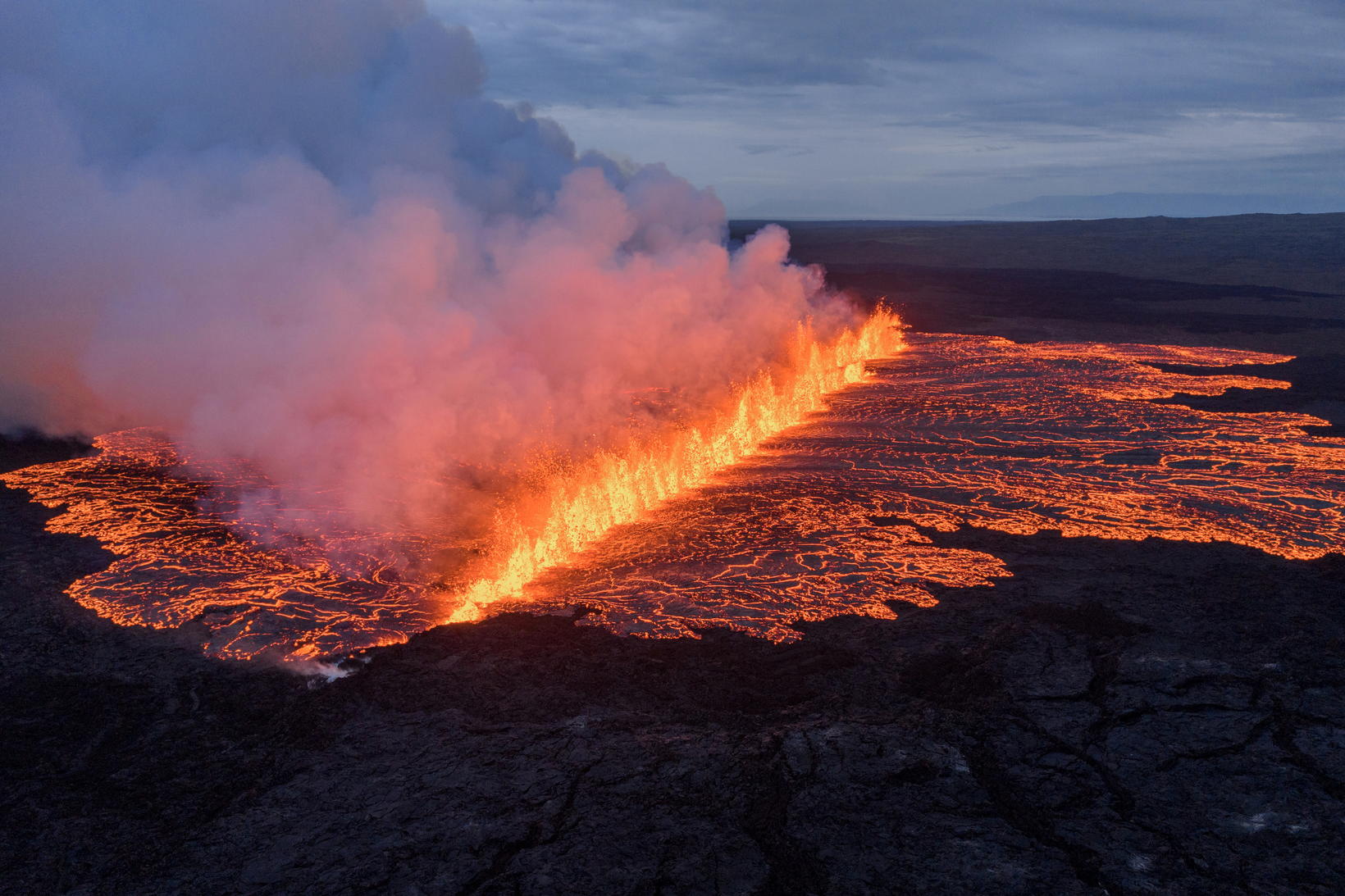What happened last night?
The eruption at the Sundhnúkagígar crater row that began last night is located northeast of Stóra-Skógfell. Photo/Hörður Kristleifsson
A volcanic eruption began on the Sundhnúkur crater row during the night — the twelfth eruption in the series since December 2023.
Benedikt Ófeigsson, head of deformation monitoring at the Icelandic Meteorological Office, told mbl.is that the eruption came as something of a surprise, even though experts knew nothing was certain.
First signs of magma movement shortly after midnight
An earthquake swarm began in the Sundhnúkur area at 11:55 p.m., and the first signs of magma movement were detected just after midnight.
More than a hundred earthquakes were recorded within about an hour after midnight, and Civil Protection raised the alert level due to the high likelihood of an eruption.
As a result, Grindavík and the Svartsengi area were evacuated. The evacuation went well, according to Hjördís Guðmundsdóttir, communications officer for Civil Protection. A number of residents remained in their homes in Grindavík, and a hotel near the Blue Lagoon had to be evacuated, where about 200 people were staying. A group of tourists was also at the campsite in Grindavík.
The HS Orka power station in Svartsengi was evacuated — two employees were on duty at the time. The company has now received permission from the Suðurnes police commissioner to send staff back in and resume operations.
Eruption southeast of Litla-Skógfell
The eruption began just before 4 a.m., with the source located southeast of Litla-Skógfell — roughly the same area where a crater formed during the August 2023 eruption.
The National Commissioner of Police declared a state of emergency in coordination with the Suðurnes police chief.
Shortly before the eruption, the Icelandic Meteorological Office estimated that the magma intrusion was about 6.5 kilometers long. Initially, based on GPS and deformation measurements, the eruption was expected to be small. Benedikt said early on that the fissure was about 700 meters long, but it has since extended and is now over 2 kilometers.
Photographer Hörður Kristleifsson recorded the accompanying video around 7 a.m., clearly showing how much the fissure had expanded.
Lava is primarily flowing eastward, toward Fagridalur and Fagradalsfjall, while the gas plume is drifting northwest toward Reykjanesbær. People with respiratory sensitivities are advised to keep windows closed.
At your own risk
The Suðurnes police chief reminds the public that residents and company staff present in danger zones do so at their own risk and are individually responsible for their actions or inaction.
It is emphasized that Grindavík is not a suitable place for families with children and that the police do not recommend anyone staying in the town, where there is considered to be a significant risk of subsidence into fissures.
Countermeasures are in effect, including mapping, geotechnical surveys, ground-penetrating radar scans, and visual inspections. Fissures have been fenced off.
However, open areas in and around Grindavík have not been specially inspected. People are advised to stick to town roads and avoid going into yards or other open areas.
Grindavík is closed to everyone except emergency responders, municipal employees, company staff, contractors, and those assisting residents. Media representatives are permitted entry under the same rules as company staff.
The eruption site is currently not accessible to tourists due to hazardous conditions. Pollution from the eruption and wildfires is significant, and air quality near the eruption site is poor. There is no organized parking or viewing area available.
The Suðurnes police chief urges drivers not to park along Reykjanesbraut. Road closures are in effect on Grindavíkurvegur, Nesvegur, and Suðurstrandarvegur. Escape routes are open via Nesvegur and Suðurstrandarvegur. The Blue Lagoon and Northern Light Inn are both closed.
Significant Eruption and Harmful Pollution
Sulfur dioxide levels reached the red alert threshold in Njarðvík around 7 a.m. This indicates unhealthy pollution levels, and both vulnerable individuals and healthy people may experience coughing, headaches, and irritation of the eyes, nose, and throat. Symptoms can be more severe in sensitive individuals.
Just before 8 a.m., Dr. Halldór Björnsson, a specialist at the Icelandic Meteorological Office, said this is a fairly substantial eruption, though not a large one. So far, there has been no decrease in activity.




/frimg/1/58/37/1583777.jpg)





